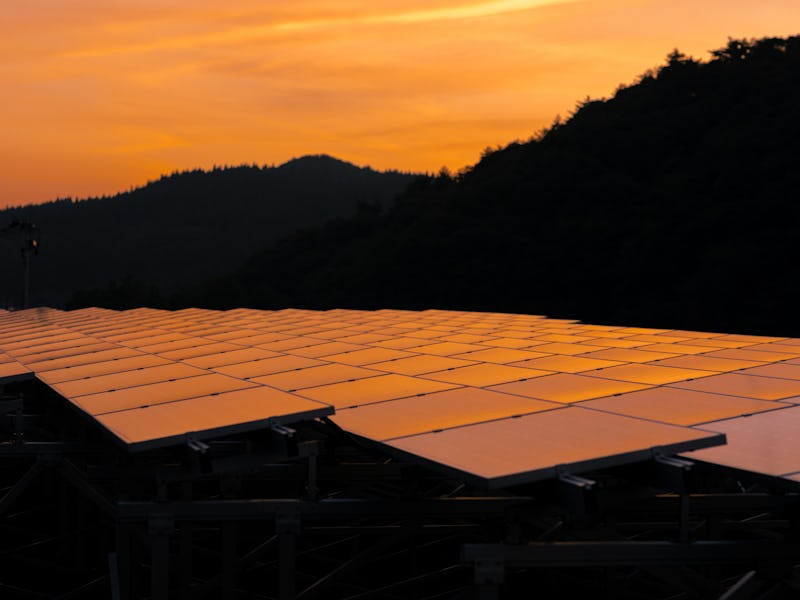Anti-solar panel that can generate power at night may be ready by 2021
The anti-solar panel could solve the problem of how we can generate electricity at night when solar panels aren't in operation.

As Inverse reported earlier this week, a recent paper outlines how we could solve one of the biggest problems with solar panels. With what's being called the "anti-solar panel," we could generate electricity at night when solar panels stop working.
Here's how it works — Space is very cold, so if you point a panel on Earth that is comparatively warm toward it, it will radiate heat as invisible infrared light. This allows you to generate electricity by capturing that power. The paper claims such a device could generate about a quarter of the electricity at night that a normal solar panel generates during the day.
This kind of device uses what is called a thermoradiative cell to generate electricity, as opposed to the photovoltaic cell used by a conventional solar panel. Whereas a solar panel is typically made of silicon, which is good at capturing light that's largely in the visible spectrum, this device has to be made of something that can capture extremely long-wavelength light.
Jeremy Munday, a professor in the Department of Electrical and Computer Engineering at UC Davis who was an author of the paper in the journal ACS Photonics, tells Inverse he's working on finding the right material for the anti-solar panel. He's looking at mercury alloys that would work quite well, but it might be the case that a new type of material that can capture as much of the long-wavelength infrared light as possible will have to be developed.
"There are particular kinds of alloys, and you can actually get some of these today. There's mercury cadmium telluride is the combination, so these materials can be put together in different ratios, and they use these for mid-infrared detectors," Munday says. "This is basically used to detect light, but the types of devices we're making are essentially the same."
Munday explains that the same kinds of materials that can be used to detect light can be used to capture the power of the infrared light. He says he'd like to develop these kinds of materials "more specifically for our application" to lower the bandgap as much as possible, which would involve partnering with people who synthesize these types of materials. Graphene could also be a good option for building this anti-solar panel.
The bandgap is how you determine photons a material can absorb. Munday says the silicon you might use for a traditional solar panel has a bandgap of 1.1 electron volts (eV). That means silicon can absorb light that is on the spectrum above 1.1 eV. To absorb infrared light, you want the bandgap to be as close to zero as possible to absorb as much of it as you can. He says the material's properties and its lattice structure determine the bandgap.
"That means it corresponds to really low-energy photons because we're dealing with really low-energy photons," Munday says. "That's what we're doing with our first prototypes and experiments. We're using these off-the-shelf materials that are able to detect this low energy light, and we're using it to try to generate power."
Beyond the materials that will be involved in this prototype, Munday says the next challenge is "finding the right places to deploy" these anti-solar panels. He says you ideally want a place that has clear skies and low humidity — as the humidity can absorb and obscure some of the energy — which is the same as what you deal with when trying to find the best location for a traditional solar array.
"You want to see out to deep space. If you have clouds, it's going to see clouds rather than deep space, and clouds are a little bit cooler than it is on the ground here but not as cold as space. If it's cloudy, it's not going to work as well."
2021?
Munday says he likely won't have a prototype built until later this year, but his team is working on the initial phases of this project as we speak.
He says the first prototype probably won't produce a lot of power, but they will continue to refine it until it's as good as it can be. He notes we've had solar panels for decades, and we're still improving on them.
"This idea of using space to transmit energy or heat from Earth is a really powerful notion," Munday says.
Abstract: Photovoltaics possess significant potential due to the abundance of solar power incident on earth; however, they can only generate electricity during daylight hours. In order to produce electrical power after the sun has set, we consider an alternative photovoltaic concept that uses the earth as a heat source and the night sky as a heat sink, resulting in a “nighttime photovoltaic cell” that employs thermoradiative photovoltaics and concepts from the advancing field of radiative cooling. In this Perspective, we discuss the principles of thermoradiative photovoltaics, the theoretical limits of applying this concept to coupling with deep space, the potential of advanced radiative cooling techniques to enhance their performance, and a discussion of the practical limits, scalability, and integrability of this nighttime photovoltaic concept.